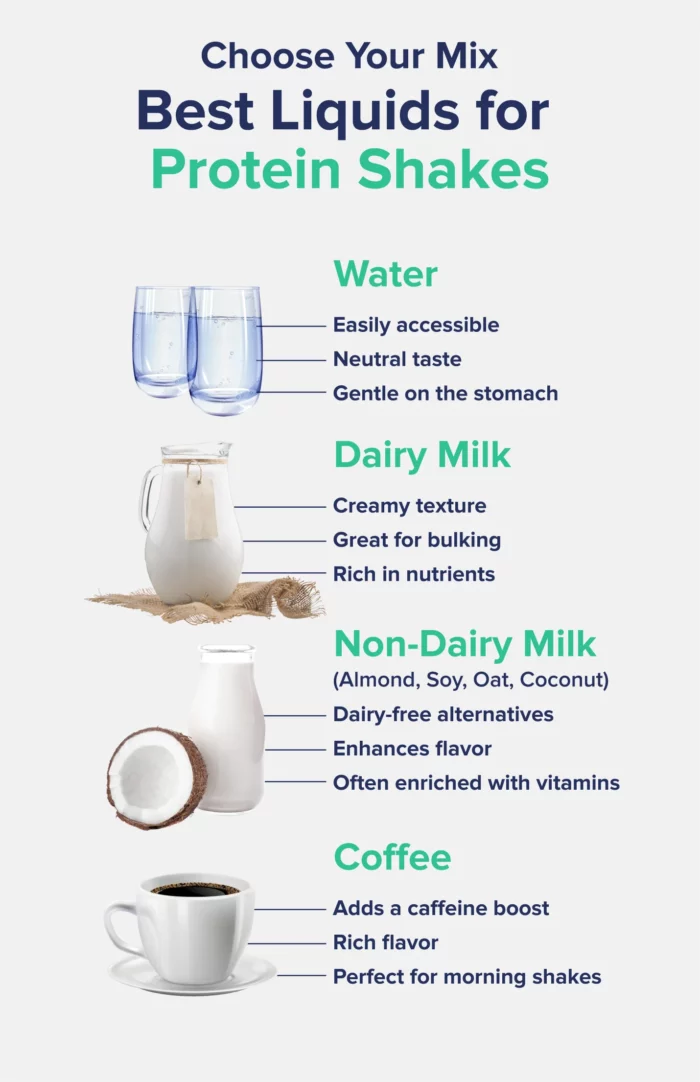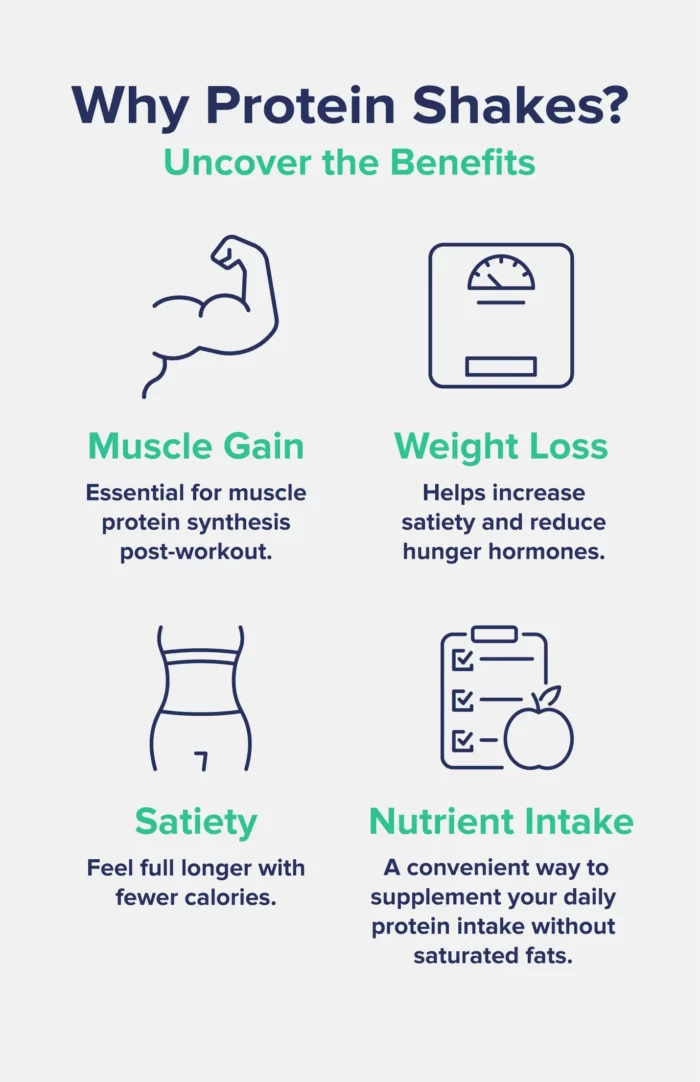Try our favorite, clean protein powder: See our top pick →
Try our favorite, clean protein powder: See our top pick →
This post contains links through which we may earn a small commission should you make a purchase from a brand. This in no way affects our ability to objectively critique the products and brands we review.
Evidence Based Research To fulfill our commitment to bringing our audience accurate and insightful content, our expert writers and medical reviewers rely on carefully curated research.
Read Our Editorial Policy
Getting enough protein can be difficult when you’re eating a high-protein diet.
This is why many people rely on supplements such as protein powder, bars, drinks, and other high-protein products to reach their desired protein intake.
Despite protein shakes being the most popular protein supplement, sometimes they can be finicky to prepare, and we can get tired of having the same thing every day.
So, grab your shaker bottle and favorite protein powder! We’re about to make protein shakes exciting again with this collection of tips and tricks for mixing up your protein powder routine.

Love them or hate them, protein shakes are one of the easiest and most convenient ways to supplement your daily protein intake when consuming a high-protein diet to help build muscle or lose weight.
However, if you’re new to using protein powder, you might have many questions about the best liquid to mix it with and tricks to making a great-tasting shake.
Name a more iconic duo than water and protein powder. We’ll wait.
In all seriousness, water is probably the best liquid for protein shakes 99% of the time since water is easily accessible, the taste is neutral, and it is unlikely to upset your stomach.
We recommend adding a scoop of protein powder to 15 to 20 ounces of room-temperature or cold water.
Shake this up, let it sit for 30 to 60 seconds to allow any clumps to dissolve, shake it again, and enjoy slowly.
Some people find the water and protein powder combo unpalatable, either due to the taste of the powder itself or the texture.
If you’re not enjoying your shakes, try mixing them with dairy milk.
Fat-free is good if you’re looking to save on calories, while whole milk will be a good option for those on a bulk (trying to gain weight).
Skim, 2%, or reduced-fat milk is also a perfectly acceptable middle-ground option.
If you are lactose intolerant, vegan, or just don’t like dairy milk, non-dairy options will also improve the flavor and texture.
Here are some of the most popular options to mix with your protein powder:
We recommend using unsweetened, non-dairy options since protein powders will already have sweeteners included.
While most people mix their protein powder with milk or water, coffee can also enhance your morning protein shake.
Here’s how: try a 50:50 combination of water with homemade or store-bought cold brew (we like Stok or Califia). We suggest sticking to classic protein flavors like vanilla (for a vanilla latte flavor) or chocolate (for a cafe mocha flavor), but you can add any flavor of protein that you like. Just shake it up and enjoy!
Some people also like to add their protein to hot coffee. This may require more trial and error as some flavors taste great with warm coffee, and others don’t.
If you try this, we recommend using a milk frother like this one to get your drink to mix smoothly.
You could also try these coffee creamers from Primal Kitchen (11g of collagen protein) or Vital Proteins (10g of collagen protein).
Few things can kill your desire to finish a protein shake more quickly than getting a mouthful of slimy, powdery clumps. Yummy, right?
Here are some tried and tested ways to reduce or totally prevent that nasty clumping:
Now for the fun part––deciding which protein powder to try!
Though whey protein powder dominates the market, it’s definitely not the only option available nowadays.
Whether you’re vegan, lactose intolerant, or have food sensitivities or allergies, there is a protein for you that fits your diet needs and goals.
To make things easier on you, here are a few of the most common protein powders you can choose from:
As we’ve said, protein powder is the easiest way to supplement your protein intake. However, in addition to its ease of use, it’s also extremely versatile!
You can add protein powder to smoothies, baked goods, and even savory meals to boost your protein intake, making it easier than ever to stick to a high-protein diet.
Try using unflavored, chocolate, or vanilla protein powder to add protein to your sweet treats. This is an excellent way to satisfy your sweet tooth and increase protein intake.
Here are a few of our very own recipes that you can easily add protein to for a little protein boost:
Smoothies are one of the best ways to drink protein powder, especially if you aren’t a fan of chugging shakes.
You can make smoothies exactly to your liking with tons of yummy ingredients that will break you out of a protein powder slump.
No more boring vanilla and chocolate shakes! Try some of these delicious smoothie combinations the next time you need a protein boost (adjust ingredients to your liking):
Peanut Butter Cup Protein Smoothie: 1 scoop chocolate protein powder, 1 tbsp natural peanut butter, 1 frozen ripe banana, 1tbsp cocoa powder, 1 cup milk or non-dairy milk
Breakfast Smoothie: 1 scoop vanilla protein powder, 1 frozen banana, ½ cup frozen strawberries, 1 tbsp oats, ½ tbsp natural peanut butter, 1 cup milk or non-dairy milk
Berry Smoothie: 1 scoop vanilla protein powder, 1 cup frozen mixed berries, 1 frozen banana, ½ cup of milk or non-dairy milk, 1 tbsp honey (optional), ¼ cup nonfat plain Greek yogurt
To make your own unique protein smoothie, try combining any of the following ingredients:
While it might initially feel strange, adding unflavored protein powder to savory meals is an excellent way to boost the protein content if you feel you’ve been lacking it lately.
Use your best judgment and don’t overdo it with the protein powder by adding it to everything, but for the occasional meal or side dish, this is perfectly fine to do!
Try adding unflavored protein powder to:

Protein plays a vital role in muscle protein synthesis to increase lean muscle mass when combined with resistance training.
A high-protein diet can also help you lose weight by increasing your satiety hormones (GIP and GLP-1) and reducing the hunger hormone (ghrelin) for a longer period of time than a diet high in carbohydrates and fats.
In effect, protein can make you feel full quicker and longer with fewer calories.
However, for the same reasons that protein is helpful for losing weight, it can also be hard to eat a lot of it, especially if you’re mainly getting it from dietary protein (animals and plants).
That’s why adding protein powder to your diet is essential to give you that protein boost you need to reach your daily goals.
Protein powder also contains no saturated fats, making it a great way to reduce the intake of animal sources of protein, which are naturally high in saturated fats.
This is one reason researchers warn that high-protein diets primarily consisting of animal sources may not be healthy in the long term.
So, the best way to eat a high-protein diet is to consume a healthy mix of protein from powders, plants, and low-fat animal proteins such as skinless chicken breast, lean beef, greek yogurt, and cottage cheese.
The best liquids to mix with protein powder are water, dairy milk, and non-dairy milk. You could also use a combination of water and coffee for an added caffeine boost in the morning. Protein powder can also be used in baked goods, protein smoothies, and even savory foods with unflavored powders.
There’s nothing you can’t mix with protein powder. However, if you have a sensitive stomach, you may want to stick to water or non-dairy milk for your protein shakes instead of milk since the excess dairy can cause an upset stomach.
You can add protein powder to baked goods like pancakes, overnight oats, energy balls, and smoothies. You can also add unflavored protein powder to savory dishes like soups, stews, pasta sauces, dips like hummus and guacamole, and even breading for chicken and fish.
Protein is essential for improving muscle gain, increasing strength, and promoting weight loss. However, some may find it challenging to eat a high-protein diet consisting of only dietary protein from whole, unprocessed foods like plants and animals. Drinking protein shakes or adding protein powder to your favorite recipes can make reaching your optimal protein intake easier.
Subscribe now and never miss anything about the topics important to you and your health.